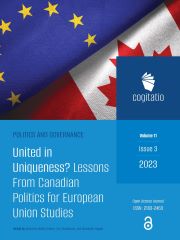Abstract
The purpose of this article is to assess the merits of comparing the EU and Canada from a federal perspective. The point of departure is that both are federal-type entities that represent deviations from the standard or mainstream American model of federalism. That has given rise to alternative conceptions, multilevel governance for the EU, and a multinational federation for Canada. The article discusses the limitations of each such notion and instead argues for the merits of seeing both as different versions of multiheaded federation which is a useful analytical device for analyzing contestation over federalism within federal-type entities. This notion directs our attention to those with power and in the position to shape the political system’s federal-constitutional nature and design, which normally happens in the realm of constitutional politics. It is the fundamental struggle over sovereignty within a federal-type structure that gives rise to the notion of a multiheaded federation—there are multiple heads because there is no willingness to accept a hierarchical arrangement. The notion of a multiheaded federation is particularly suitable for capturing (de)federalisation processes and dynamics.
Full info
John Erik Fossum
Multiheaded Federations: The EU and Canada compared
Politics and Governance, 2023, 11(3).
DOI: https://doi.org/10.17645/pag.v11i3.6830
